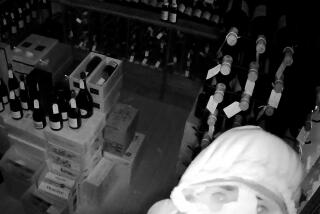Replaces Brother in Shake-Up : Don Sebastiani Takes Over as Winery Head
Sam Sebastiani has been ousted as president of family-owned Sebastiani Winery in Sonoma--California’s eighth largest--in a shake-up ordered by the clan’s matriarch, Sylvia, who named her younger son, Assemblyman Don Sebastiani (R-Sonoma), as chairman and chief executive.
Sylvia Sebastiani stepped aside as chairman, a post she has held since inheriting 90% of the company’s stock in 1980 on the death of her husband, August. She remains the holder of what Don Sebastiani described as “the vast majority” of the corporation’s stock.
“She is giving up absolutely no power,” he said in an interview Tuesday.
Winery spokesmen deferred all comment to the assemblyman, whose district covers much of California’s premium wine country. Sam Sebastiani could not be reached for comment.
Don Sebastiani said the moves, which took place over the last week, will not affect his previously announced plan to resign the lower house seat that he has held since 1980 in favor of running for statewide office, either lieutenant governor or controller.
“You can expect no change in political plans or political approach as a result of this move,” he said.
The decision to continue a political career underscores one major difference in approach between the two brothers. Don Sebastiani had acceded to his older brother’s request that he choose between politics and the wine business by surrendering his interest in the winery in October, 1983.
Don Sebastiani declined to comment on his brother’s ouster, but he said Sam was given the option of resigning but refused. “All I will say is that he’s my brother and a darned good man, and I wish him well.”
The outspoken assemblyman, who is 32, has accumulated his share of political foes since his election to the lower house in 1980.
His first political notoriety stemmed from sponsorship of an initiative to reapportion the Legislature, a move that embittered many Democrats. At one point, the party’s Alameda County central committee sold buttons featuring a Sebastiani wine bottle in a circle with a line through it and the word poison . He later created a stir when he quipped that he supported sending female astronauts into space “as long as they have a one-way ticket.”
To 45-year-old Sam Sebastiani, who holds a graduate degree in management, the winery didn’t need such political associations.
“This winery is not engaged in politics,” he told a Times reporter at the time. “We don’t want anybody, Republican or Democrat, to make a wine-buying choice based on anything other than the quality of the wine.”
Assemblyman Sebastiani said no immediate change is contemplated in corporate strategy. Under Sam’s leadership, the winery sought to shed its image as a producer of mostly generic jug wines in favor of making higher-margin fine table wines.
“It would be premature for us to project what the overall tone of the corporation will be,” Don Sebastiani said. The immediate goal, he added, is to make a smooth transition under the new leadership.
Sebastiani said his brother-in-law, Richard Cuneo, the winery’s vice president for administration, will serve as interim president and chief operating officer. The two executives will recruit a permanent replacement.
Sebastiani winery has been owned and operated by the family since Samuele Sebastiani, the grandfather of Sam and Don, bought a former Sonoma mission vineyard and the present winery in 1904. August took over in 1944, when the winery was still producing bulk wine for some of California’s leading brands.
It was August who began putting the Sebastiani name on the label and pursued the emerging American market for wine by selling it in jug-size bottles. In 1975, Sebastiani became the first wine maker to bottle prized varietals in 1.5-liter magnums. Sales took off almost immediately with sales doubling from 500,000 cases in a single year.
Since Sam Sebastiani’s takeover following his father’s death in 1980, sales have slipped from 4 million 9-liter cases to 2.5 million cases in 1984, according to the trade journal Impact. While some of the decline reflected an industrywide flattening of demand and the inroad of cheap imported wines, some of it was also due to Sebastiani’s strategy to move the winery out of the low-margin, generic wine market and into higher-margin varietal wines.
To carry out the fine-wine strategy, the winery has invested more than $6 million in new technology while striving, in its advertising, to create a new Sebastiani image.
Sam Sebastiani made news in wine circles when he recalled from store shelves some $2 million worth of wine that he judged no longer lived up to the Sebastiani standard.
Generic “Mountain” wines, which accounted for 75% of the winery’s sales in 1980, now account for less than half. New “Country” varietals now make up more than 31% of sales, with vintage varietals accounting for the balance, according to Impact.
More to Read
Sign up for Essential California
The most important California stories and recommendations in your inbox every morning.
You may occasionally receive promotional content from the Los Angeles Times.










